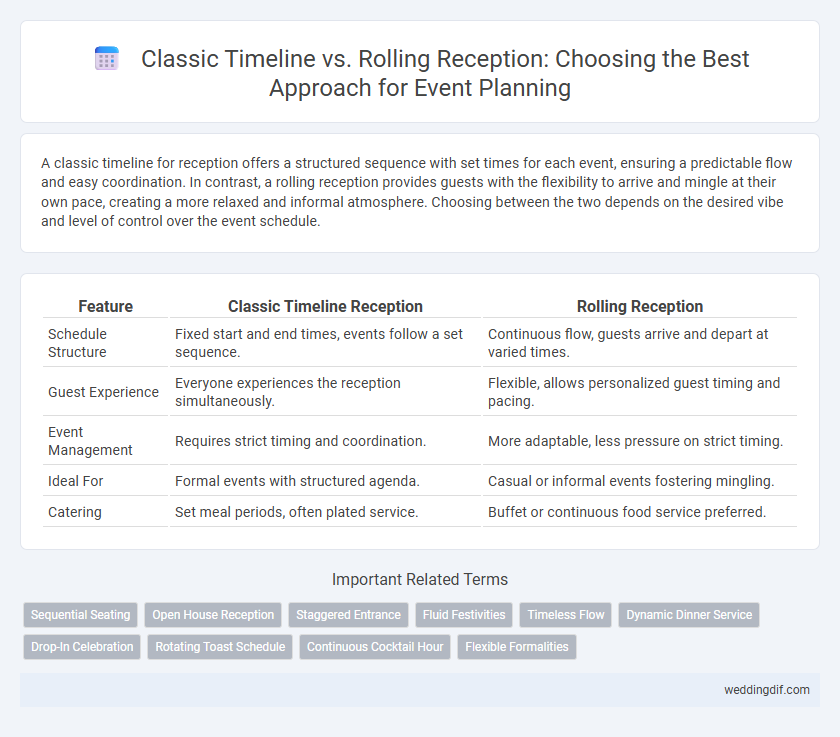A classic timeline for reception offers a structured sequence with set times for each event, ensuring a predictable flow and easy coordination. In contrast, a rolling reception provides guests with the flexibility to arrive and mingle at their own pace, creating a more relaxed and informal atmosphere. Choosing between the two depends on the desired vibe and level of control over the event schedule.
Table of Comparison
| Feature | Classic Timeline Reception | Rolling Reception |
|---|---|---|
| Schedule Structure | Fixed start and end times, events follow a set sequence. | Continuous flow, guests arrive and depart at varied times. |
| Guest Experience | Everyone experiences the reception simultaneously. | Flexible, allows personalized guest timing and pacing. |
| Event Management | Requires strict timing and coordination. | More adaptable, less pressure on strict timing. |
| Ideal For | Formal events with structured agenda. | Casual or informal events fostering mingling. |
| Catering | Set meal periods, often plated service. | Buffet or continuous food service preferred. |
Understanding the Classic Wedding Reception Timeline
Understanding the classic wedding reception timeline involves a structured sequence of events starting with the couple's entrance, followed by dinner, speeches, cake cutting, and dancing. This traditional format allows guests to anticipate key moments and ensures smooth transitions between activities. The rolling reception, by contrast, offers a more flexible schedule where guests arrive and participate at varied times, creating a dynamic atmosphere but requiring careful coordination to keep the event cohesive.
What is a Rolling Reception?
A Rolling Reception is a flexible event format where guests arrive and depart at staggered times, allowing continuous mingling without the constraints of a fixed schedule. Unlike a Classic Timeline Reception, which follows a predetermined sequence of activities, a Rolling Reception creates a more casual and dynamic atmosphere. This approach enhances guest interaction and accommodates varying schedules, making it ideal for modern events with diverse attendee availability.
Key Differences: Classic vs. Rolling Reception
Classic Timeline receptions follow a fixed schedule with designated times for activities such as cocktails, dinner, speeches, and dancing, ensuring structured flow and guest engagement. Rolling receptions offer a more flexible format where guests arrive and mingle at different times, creating a dynamic atmosphere with continuous food and drink service. Classic timelines emphasize organization and predictability, while rolling receptions prioritize spontaneity and casual interaction.
Pros and Cons of a Classic Reception
A Classic Reception offers a well-structured schedule that ensures key moments like speeches, dinner, and dancing occur at predetermined times, providing clear expectations for guests and organizers. This format can enhance formality and coordination but may feel rigid and limit spontaneous interaction compared to more flexible options. The fixed timeline also requires careful planning to avoid delays, which can affect the overall flow and guest experience.
Pros and Cons of a Rolling Reception
A Rolling Reception offers flexibility by allowing guests to arrive and mingle at various times, reducing crowd congestion and encouraging continuous interaction, which enhances networking opportunities. However, it can lead to uneven food consumption and staffing challenges, as servers must be prepared to accommodate guests sporadically over an extended period. This format may also dilute the event's atmosphere by lacking a centralized moment for speeches or formal announcements, potentially diminishing engagement.
Guest Experience: Which Reception Suits Them Best?
Classic Timeline receptions offer a structured flow with designated times for arrival, speeches, and dinner, appealing to guests who appreciate predictability and formality. Rolling receptions provide a flexible, drop-in style event that suits guests who enjoy casual mingling and a relaxed atmosphere without a strict schedule. Understanding guest preferences--whether they favor organized elegance or informal socializing--helps determine the ideal reception format for enhancing overall experience.
Impact on Venue and Vendors
Classic Timeline receptions require precise scheduling, allowing venues to allocate resources efficiently and vendors to prepare for set service times, minimizing downtime. Rolling receptions offer flexibility, enabling venues to accommodate fluctuating guest arrivals but may challenge vendors with unpredictable demand and service pacing. The choice affects venue logistics and vendor coordination, influencing event flow and resource utilization.
Budget Considerations for Each Reception Style
Classic Timeline receptions typically require more fixed costs due to set schedules, which often involve predetermined vendor hours and venue rentals leading to higher upfront expenses. Rolling reception styles offer flexibility that can reduce costs by minimizing overtime charges and allowing for staggered food and beverage service, making it a budget-friendly choice for couples. Evaluating vendor fees, guest count variations, and the desired flow will significantly impact the overall budget for both reception styles.
Making the Right Choice for Your Wedding Vision
Choosing between a classic timeline and a rolling reception depends on your wedding vision and guest experience preferences. A classic timeline offers structured moments like formal entrance, speeches, and dinner, ensuring a predictable flow, while a rolling reception encourages mingling and flexibility with food served continuously. Understanding your priorities for atmosphere, interaction, and event pacing helps determine which style best aligns with your celebration goals.
Tips for Planning Your Ideal Reception Timeline
For planning your ideal reception timeline, consider whether a classic timeline with structured events or a rolling reception with a relaxed flow suits your style better. Classic timelines provide clarity for seating, speeches, and meals, ensuring smooth transitions, while rolling receptions promote mingling and flexibility. Prioritize your guest experience by balancing formal moments with casual interaction to keep energy high throughout the event.
Classic Timeline vs Rolling Reception for Reception. Infographic

 weddingdif.com
weddingdif.com